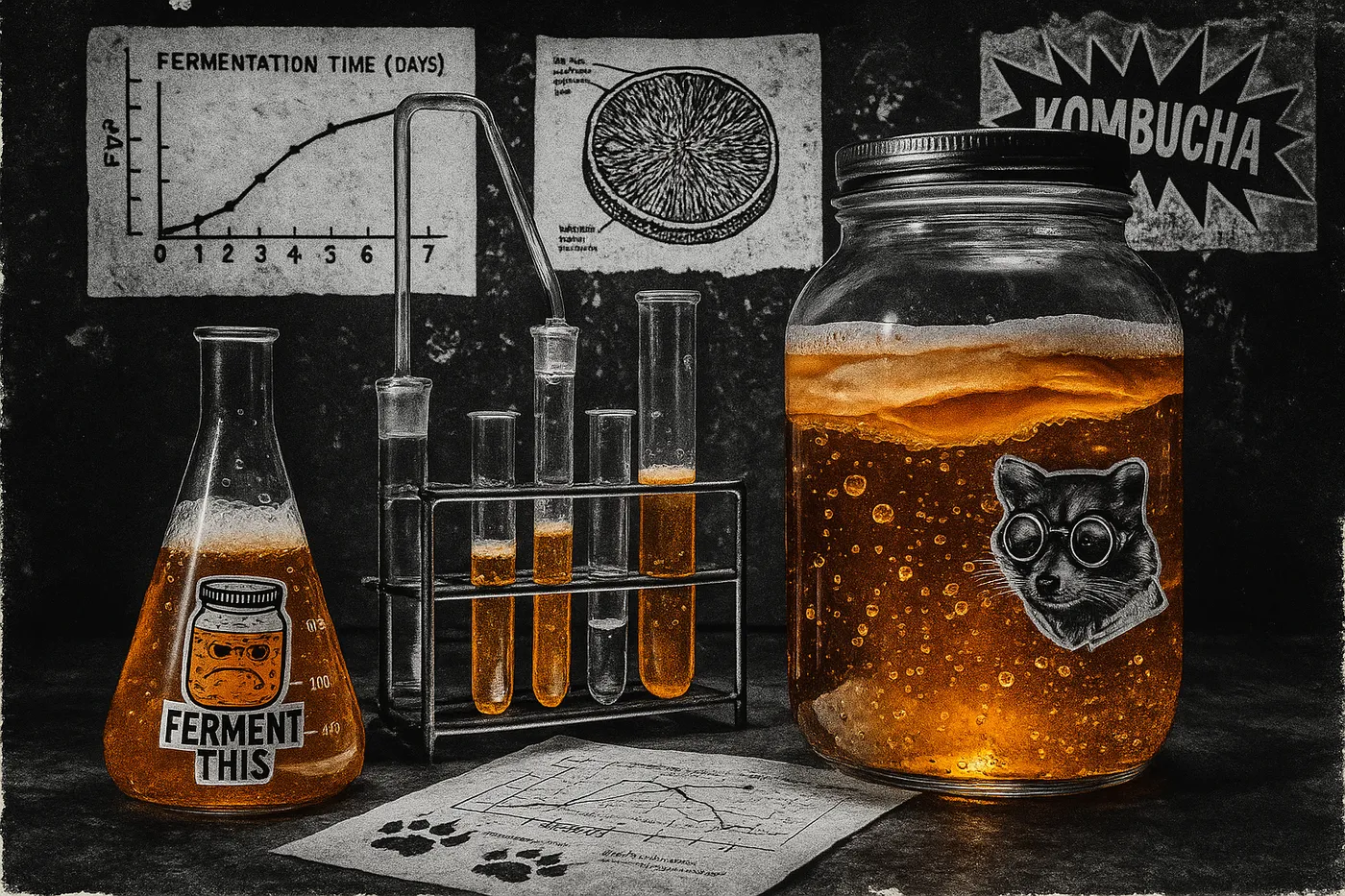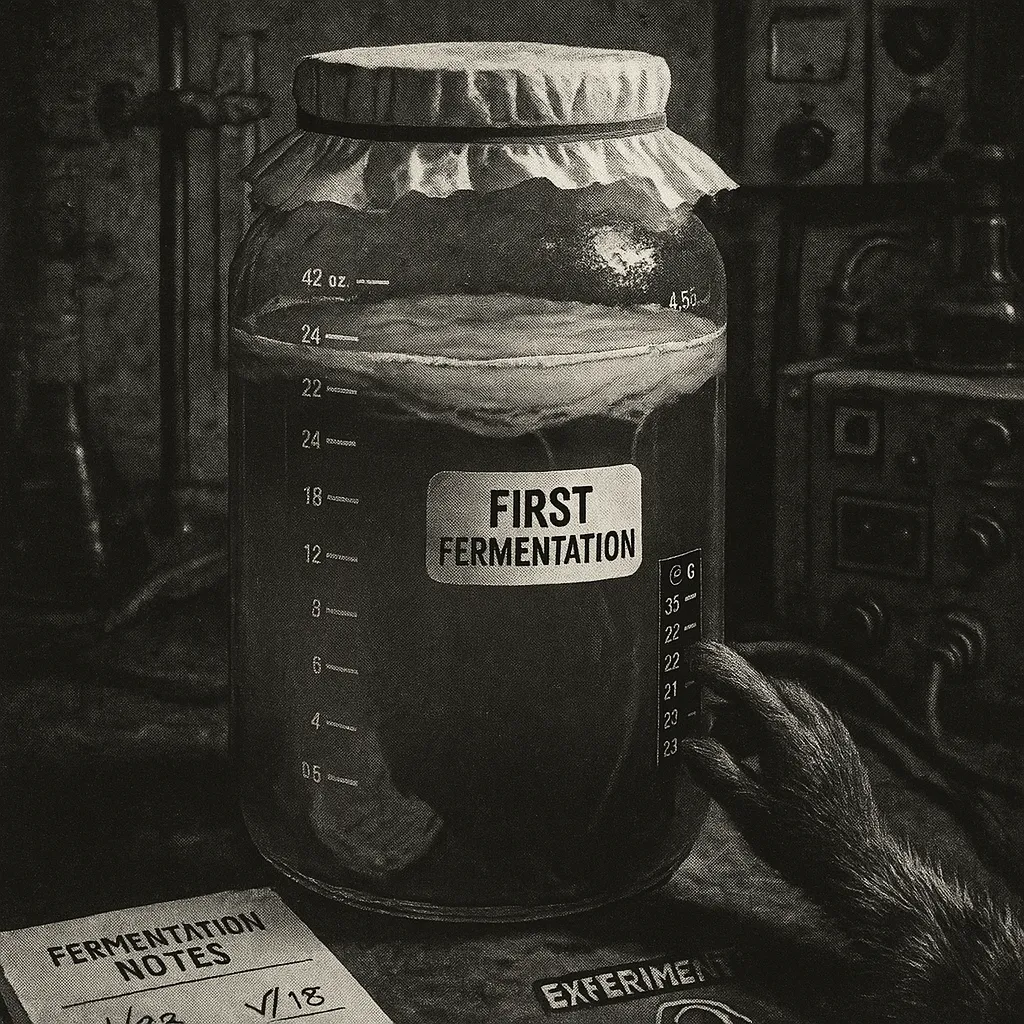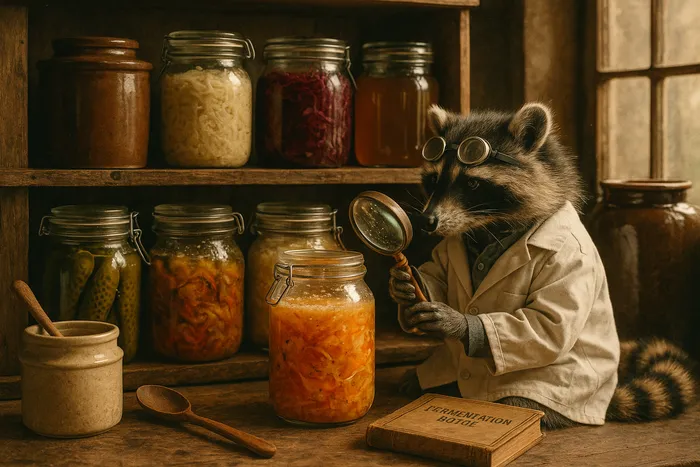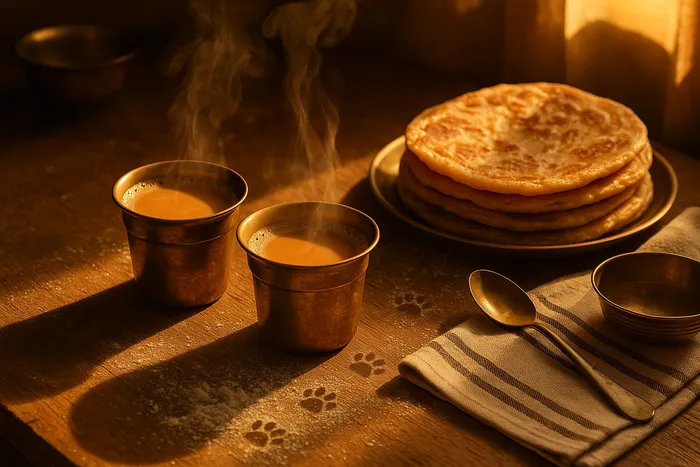fermentation
The Kombucha Chronicles: From SCOBY to Fizzy

Raccook
January 19, 2025
5min read

I'll admit it — the first time I saw a SCOBY, I thought someone had left a jellyfish in a jar. This alien-looking disc floating in murky tea turned out to be the gateway to one of my favorite fermentation adventures. After months of buying overpriced bottles at the store (and maybe sneaking a few extra samples at the farmers market), I decided it was time to brew my own.
The journey from skeptical observer to kombucha brewer has been equal parts science experiment and kitchen magic. There's something deeply satisfying about feeding sugar tea to a living culture and watching it transform into something tangy, fizzy, and alive.
The SCOBY Situation
SCOBY stands for Symbiotic Culture of Bacteria and Yeast, but I prefer to think of it as a Slightly Creepy Object Brewing Yummies. This rubbery disc is your fermentation engine, converting sweet tea into probiotic-rich kombucha through the magic of fermentation.
Getting your first SCOBY is like joining a secret society. You can:
- Beg one from a kombucha-brewing friend (they multiply like pancakes)
- Grow your own from a bottle of raw, unflavored kombucha
- Order one online (less romantic but more reliable)
- Check local fermentation groups or farmers markets
First Fermentation Essentials
The Basic Brew
🫖 8 cups filtered water
🌿 8 bags black or green tea (or 3 tablespoons loose tea)
🍯 1 cup sugar (plain white works best)
🪼 1 SCOBY with starter liquid
🫙 1 gallon glass jar
☕ 1-2 cups starter tea from previous batch
The Process
-
Brew the sweet tea base: Boil 4 cups of water, steep tea for 10-15 minutes, then stir in sugar until dissolved. Add remaining 4 cups of cold water to cool it down faster.
-
Cool completely: This is crucial — hot tea will murder your SCOBY. Room temperature is the goal. I learned this the hard way with SCOBY #1 (RIP).
-
Transfer to fermentation jar: Pour cooled tea into your gallon jar, add the starter tea, then gently slide in your SCOBY. It might sink, float, or hover mysteriously in the middle — all normal.
-
Cover and wait: Use a coffee filter or tight-weave cloth secured with a rubber band. This lets it breathe while keeping fruit flies out (they love kombucha as much as we do).
-
Ferment for 7-10 days: Taste after day 5 using a clean straw. You want a balance of sweet and tart. Too sweet? Let it go longer. Too vinegary? You've gone too far (but save it for salad dressing).

Second Fermentation Magic
This is where kombucha gets fun. The second fermentation adds carbonation and flavor while letting you play mad scientist with combinations.
Flavoring Ideas That Actually Work
After many experiments (and a few explosive failures), here are my go-to flavorings:
Ginger Lemon: Classic for a reason. 1 tablespoon fresh grated ginger + juice of half a lemon per 16oz bottle
Berry Hibiscus: 2 tablespoons mixed berries + 1 teaspoon dried hibiscus flowers
Pineapple Turmeric: 3 tablespoons fresh pineapple + 1/2 teaspoon ground turmeric + pinch of black pepper
Apple Cinnamon: 3 tablespoons apple juice + 1 cinnamon stick
Mango Chili: 3 tablespoons mango puree + tiny pinch of chili flakes
Second Fermentation Steps
-
Reserve your SCOBY: With clean hands, transfer SCOBY and 2 cups of liquid to a clean jar for your next batch.
-
Bottle the kombucha: Using a funnel, fill bottles leaving 1-2 inches headspace. Add your chosen flavorings.
-
Seal and ferment: Cap tightly and leave at room temperature for 2-4 days. The trapped CO2 creates carbonation.
-
Refrigerate: Once fizzy enough, move to the fridge to slow fermentation and prevent bottle bombs.
Troubleshooting Your Brew
Too sweet after 10 days? Your kombucha might be too cold. It ferments best between 75-85°F. Try moving it somewhere warmer.
Mold on your SCOBY? Unlike the normal stringy brown bits, mold is fuzzy and colorful (green, black, or blue). Toss everything and start fresh — no salvaging moldy batches.
No carbonation? Your bottles might not seal properly, or you need more sugar in the second fermentation. Try adding 1/2 teaspoon sugar per bottle.
Too vinegary? You've created kombucha vinegar! Don't toss it — use for salad dressings or as starter tea for your next batch (use less than normal).

SCOBY Hotel Management
As you brew, your SCOBY will grow babies — thin layers that form on top during fermentation. Soon you'll have more SCOBYs than you know what to do with. Enter the SCOBY hotel:
- Large glass jar with lid
- Sweet tea mixture (same recipe as brewing)
- Stack SCOBYs like pancakes with liquid covering them
- Store at room temperature feeding fresh sweet tea monthly
Extra SCOBYs make great gifts for aspiring fermenters, compost additions, or even SCOBY fruit leather (dehydrate with fruit puree — surprisingly good).
The Continuous Brew Method
Once you're hooked, consider continuous brewing. Keep a jar with spigot going constantly, drawing off finished kombucha and adding fresh sweet tea to replace it. It's like having a kombucha tap in your kitchen — dangerous but delightful.
Safety and Sanitation
Fermentation is forgiving, but cleanliness matters:
- Always use clean utensils and jars
- Avoid metal (except stainless steel) — it can react with acids
- Trust your nose — kombucha should smell pleasantly vinegary, not rotten
- When in doubt, throw it out
The Fermented Life
Brewing kombucha has taught me patience, introduced me to a community of fermentation enthusiasts, and saved me approximately one million dollars in store-bought bottles. Plus, there's something deeply satisfying about creating your own supply of fizzy, probiotic goodness.
My kitchen counter now hosts a small kombucha operation — three gallons brewing, a SCOBY hotel, and usually a dozen bottles in various stages of second fermentation. Friends know to bring empty bottles when they visit, leaving with filled ones and brewing tips.
The transformation from sweet tea to tangy kombucha still feels like magic, even after hundreds of batches. Each brew is slightly different, influenced by temperature, time, and the particular mood of your SCOBY. It's alive, unpredictable, and absolutely worth the counter space.
Related Fermentation Adventures
Ready to expand your fermentation empire? Try:
- Fermentation Journey - The comprehensive guide to all things fermented
- Water Kefir - Kombucha's lighter, dairy-free cousin
- Sourdough Starter Guide - Another living culture to nurture
Happy brewing, and may your SCOBYs be ever healthy and your bottles perfectly fizzy!








